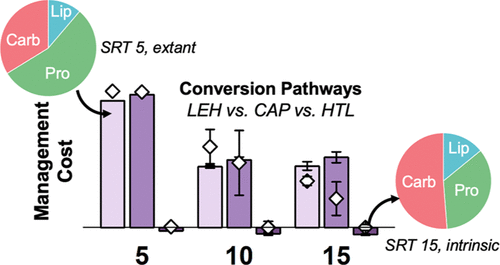当前位置:
X-MOL 学术
›
Environ. Sci. Technol.
›
论文详情
Our official English website, www.x-mol.net, welcomes your feedback! (Note: you will need to create a separate account there.)
Solids Residence Time Impacts Carbon Dynamics and Bioenergy Feedstock Potential in Phototrophic Wastewater Treatment Systems
Environmental Science & Technology ( IF 11.4 ) Pub Date : 2021-09-03 , DOI: 10.1021/acs.est.1c02590 Ian M Bradley 1, 2 , Yalin Li 3 , Jeremy S Guest 3, 4
Environmental Science & Technology ( IF 11.4 ) Pub Date : 2021-09-03 , DOI: 10.1021/acs.est.1c02590 Ian M Bradley 1, 2 , Yalin Li 3 , Jeremy S Guest 3, 4
Affiliation

|
The use of wastewater-grown microalgae has the potential to reduce the cost of algae-derived biofuels while simultaneously advancing nutrient recovery at water resource recovery facilities (WRRFs). However, a significant barrier has been the low yield and high protein content of phototrophic biomass. Here, we examine the use of solids residence time (SRT) as a selective pressure in driving biochemical composition, yield, biofuel production, and WRRF nutrient management cost. We cultivated mixed phototrophic communities in controlled, laboratory-scale photobioreactors on the local WRRF secondary effluent to link SRT with biochemical composition and techno-economic analysis to yield insights into biomass composition and downstream processing effects on minimum fuel selling price. SRT significantly impacted biochemical composition, with total and dynamic carbohydrates the highest at low SRT (total carbohydrates being 0.60 and 0.32 mg-carbohydrate·mg-protein–1 at SRT 5 and 15 days, respectively). However, there were distinct differences between extant, steady-state performance and intrinsic potential, and longer SRT communities were able to accumulate significant fractions (51% on an ash-free dry weight basis, AFDW %) of carbohydrate reserves under nutrient starvation. Overall, hydrothermal liquefaction (HTL) was found to be more suitable than lipid extraction for hydrotreating (LEH) and combined algal processing (CAP) for conversion of biomass to fuels, but LEH and CAP became more competitive when intrinsic carbon storage potential was realized. The results suggest that the use of algae for nutrient recovery could reduce the nutrient management cost at WRRFs through revenue from algal biofuels, with HTL resulting in a net revenue.
中文翻译:

固体停留时间影响光养废水处理系统中的碳动力学和生物能源原料潜力
使用废水生长的微藻有可能降低藻类生物燃料的成本,同时促进水资源回收设施 (WRRF) 的养分回收。然而,一个重要的障碍是光养生物量的低产量和高蛋白质含量。在这里,我们研究了使用固体停留时间 (SRT) 作为驱动生化成分、产量、生物燃料生产和 WRRF 养分管理成本的选择压力。我们在当地 WRRF 二级流出物的受控实验室规模光生物反应器中培养了混合光养群落,将 SRT 与生化成分和技术经济分析联系起来,以深入了解生物质成分和下游加工对最低燃料销售价格的影响。SRT 显着影响生化成分,–1 分别在 SRT 5 天和 15 天)。然而,现存的、稳态的性能和内在潜力之间存在明显差异,在营养缺乏的情况下,较长的 SRT 社区能够积累显着的碳水化合物储备分数(51%,以无灰干重为基础,AFDW%)。总体而言,发现水热液化 (HTL) 比脂质提取更适合加氢处理 (LEH) 和联合藻类加工 (CAP) 将生物质转化为燃料,但当实现固有的碳储存潜力时,LEH 和 CAP 变得更具竞争力。结果表明,使用藻类进行养分回收可以通过藻类生物燃料的收入降低 WRRF 的养分管理成本,HTL 产生净收入。
更新日期:2021-09-21
中文翻译:

固体停留时间影响光养废水处理系统中的碳动力学和生物能源原料潜力
使用废水生长的微藻有可能降低藻类生物燃料的成本,同时促进水资源回收设施 (WRRF) 的养分回收。然而,一个重要的障碍是光养生物量的低产量和高蛋白质含量。在这里,我们研究了使用固体停留时间 (SRT) 作为驱动生化成分、产量、生物燃料生产和 WRRF 养分管理成本的选择压力。我们在当地 WRRF 二级流出物的受控实验室规模光生物反应器中培养了混合光养群落,将 SRT 与生化成分和技术经济分析联系起来,以深入了解生物质成分和下游加工对最低燃料销售价格的影响。SRT 显着影响生化成分,–1 分别在 SRT 5 天和 15 天)。然而,现存的、稳态的性能和内在潜力之间存在明显差异,在营养缺乏的情况下,较长的 SRT 社区能够积累显着的碳水化合物储备分数(51%,以无灰干重为基础,AFDW%)。总体而言,发现水热液化 (HTL) 比脂质提取更适合加氢处理 (LEH) 和联合藻类加工 (CAP) 将生物质转化为燃料,但当实现固有的碳储存潜力时,LEH 和 CAP 变得更具竞争力。结果表明,使用藻类进行养分回收可以通过藻类生物燃料的收入降低 WRRF 的养分管理成本,HTL 产生净收入。



























 京公网安备 11010802027423号
京公网安备 11010802027423号